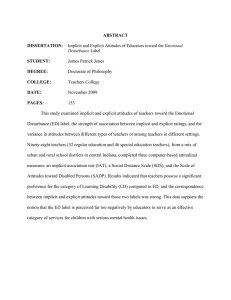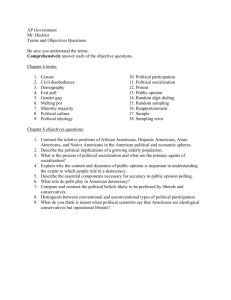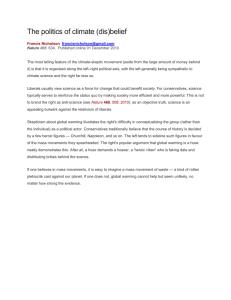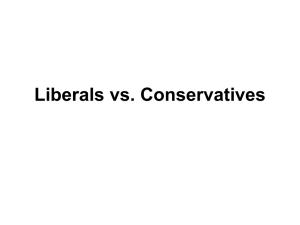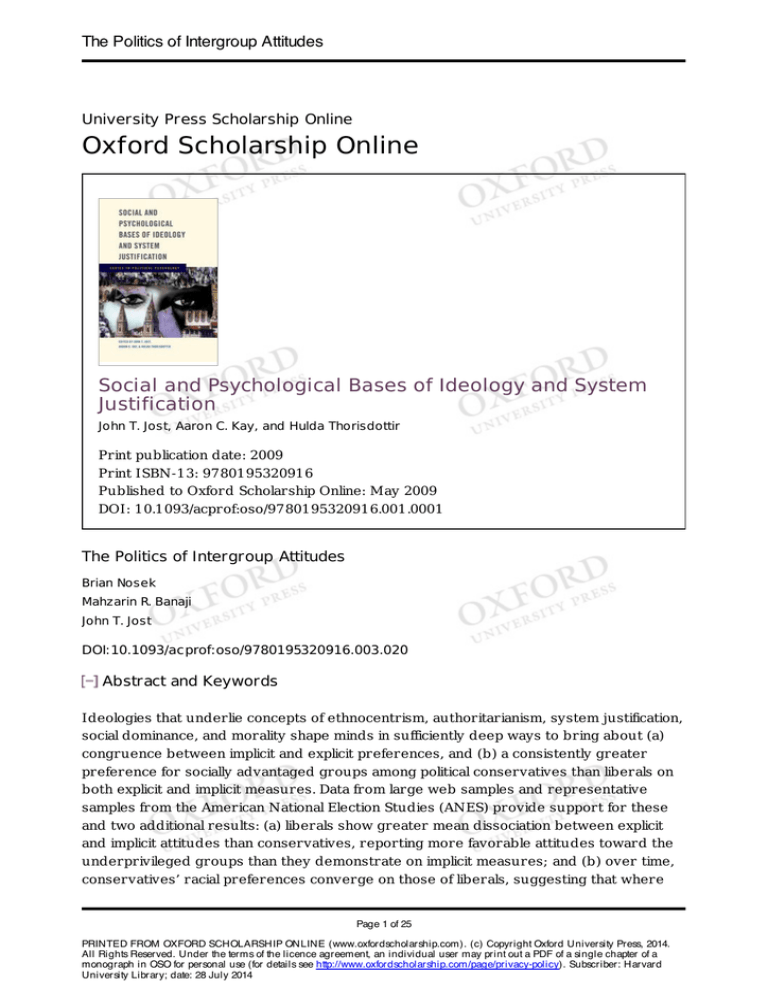
The Politics of Intergroup Attitudes
UniversityPressScholarshipOnline
OxfordScholarshipOnline
SocialandPsychologicalBasesofIdeologyandSystem
Justification
JohnT.Jost,AaronC.Kay,andHuldaThorisdottir
Printpublicationdate:2009
PrintISBN-13:9780195320916
PublishedtoOxfordScholarshipOnline:May2009
DOI:10.1093/acprof:oso/9780195320916.001.0001
ThePoliticsofIntergroupAttitudes
BrianNosek
MahzarinR.Banaji
JohnT.Jost
DOI:10.1093/acprof:oso/9780195320916.003.020
AbstractandKeywords
Ideologiesthatunderlieconceptsofethnocentrism,authoritarianism,systemjustification,
socialdominance,andmoralityshapemindsinsufficientlydeepwaystobringabout(a)
congruencebetweenimplicitandexplicitpreferences,and(b)aconsistentlygreater
preferenceforsociallyadvantagedgroupsamongpoliticalconservativesthanliberalson
bothexplicitandimplicitmeasures.Datafromlargewebsamplesandrepresentative
samplesfromtheAmericanNationalElectionStudies(ANES)providesupportforthese
andtwoadditionalresults:(a)liberalsshowgreatermeandissociationbetweenexplicit
andimplicitattitudesthanconservatives,reportingmorefavorableattitudestowardthe
underprivilegedgroupsthantheydemonstrateonimplicitmeasures;and(b)overtime,
conservatives’racialpreferencesconvergeonthoseofliberals,suggestingthatwhere
Page 1 of 25
PRINTED FROM OXFORD SCHOLARSHIP ONLINE (www.oxfordscholarship.com). (c) Copyright Oxford University Press, 2014.
All Rights Reserved. Under the terms of the licence agreement, an individual user may print out a PDF of a single chapter of a
monograph in OSO for personal use (for details see http://www.oxfordscholarship.com/page/privacy-policy). Subscriber: Harvard
University Library; date: 28 July 2014
The Politics of Intergroup Attitudes
liberalsaretoday,conservativeswillbetomorrow.
Keywords:conservatism,elections,ethnocentrism,intergroup,liberalism,morality,systemjustification
Intergroupattitudesaremadeupofcomplexstrandsofsocialpreferences.Theyare
heldtogetherbypoliticalideologiesthatserveasorientingsystemsguidingpersonality,
aswellasresponsestotheenvironmentsuchasdecisionsabouttheinformationone
choosestoconsume,theactivitiesonepursues,andthepoliciesonesupports(Jost,
2006).Theyaresufficientlycentraltosocialcognitionthattheyarevisibleintheneural
markersthatdistinguishapoliticallysimilarotherfromonewhoisdissimilar(Mitchell,
Macrae,&Banaji,2006).
Inthischapter,werelyontwolargedatasetsthatprovidesubstantialevidence
regardingattitudestowardmultiplesocialgroups(e.g.,groupsbasedonreligion,
sexuality,ethnicity/race,age,andgender).Fromthesedata,weexaminetheroleof
politicalideologyasanorganizingconceptforthestructureandfunctionofsocial
attitudes;simultaneously,weexamineintergroupattitudestounderstandmoreabout
theliberal–conservative(orleft–right)politicaldivide.
Inthelasttwodecades,theideathatattitudes,likeothermentalprocesses,mayreside
inbothconscious/explicitaswellaslessconscious/implicitformshascometobewellaccepted(e.g.,Bargh,1997;Greenwald&Banaji,1995).Thisdistinctioninattitudesmay
applytophilosophicalandideologicalbeliefsystemsaswell(Jost,Banaji,&Nosek,2004;
Jost,Glaser,(p.481) Kruglanski,&Sulloway,2003).Thatis,politicalideology—an
interconnectedsetofbeliefsandattitudesthatshapejudgment—maynotexistsolelyasa
reasonedorexplicitcollectionofbeliefsandattitudes.Ideologyhasunconsciousaswell
asconsciousdeterminants,andthelatterarewellexplicatedelsewhere(Cunningham,
Nezlek,&Banaji,2004;seealsoFerguson,Carter,&Hassin,thisvolume).
Inthischapter,weexaminethevariationinideologicalorientationinrelationtoimplicitand
explicitattitudes,withaspecificfocusonattitudestowardsocialgroups.Westartby
revisitingJostandcolleagues’(2003)theoreticalargument(andsupportingmeta-analysis)
thatliberalsandconservativesdifferontwokeydimensions:resistancetochangeand
toleranceforinequality.Wethenfocusonthekeypredictionthatconservativesaremore
likelythanliberalstohaveandexpressmorepositiveattitudestowardhigh-statusor
advantagedgroupsandmorenegativeattitudestowardlow-statusordisadvantaged
groups.Thisoccursonbothconsciousandlessconsciousmeasuresofintergroup
attitudes.Inthissense,theintergroupattitudesofconservativestendtobemore
system-justifyingthanthoseofliberals,insofarastheysupportandperpetuatethe
existingsocialhierarchy(seeJostetal.,2004;Jost,Nosek,&Gosling,2008).Wealsofind
—usingdatafromtheAmericanNationalElectionStudies(ANES)—thatliberalshaveat
theforefrontofthesocialmovementtowardracialegalitarianism,whereasconservatives’
attitudeswereslowertochange.
IDEOLOGICALDIFFERENCESBETWEENLIBERALSANDCONSERVATIVES
The“classic”conceptionoftheauthoritarianpersonality(Adorno,Frenkel-Brunswik,
Page 2 of 25
PRINTED FROM OXFORD SCHOLARSHIP ONLINE (www.oxfordscholarship.com). (c) Copyright Oxford University Press, 2014.
All Rights Reserved. Under the terms of the licence agreement, an individual user may print out a PDF of a single chapter of a
monograph in OSO for personal use (for details see http://www.oxfordscholarship.com/page/privacy-policy). Subscriber: Harvard
University Library; date: 28 July 2014
The Politics of Intergroup Attitudes
Levinson,&Sanford,1950),itsmoderninstantiation(Altemeyer,1996),recent
perspectivesonideologystressingmotivatedsocialcognition(Jostetal.,2003),system
justification(Jost&Banaji,1994;Jostetal.,2004,2008),socialdominance(Sidanius&
Pratto,1999),andmoralfoundations(Haidt&Graham,2007)provideaccountsof
differencesbetweenthepoliticalleftandright,or,morecommonlyintheUnitedStates,
liberalismandconservatism.Theseperspectivesconvergeontheexpectationthat,
comparedtoliberals,conservativesarelessconcernedwithequality,morecomfortable
maintainingthestatusquo,andmorelikelytoshowfavoritismforhigh-statusor
advantagedgroupsoverlow-statusordisadvantagedgroups.
Totheextentthatconservative,system-justifyingattitudesarecharacterizedby
resistancetochangeandtoleranceforinequality(Jostetal.,2003),theirappealshouldbe
maximizedwhenstabilityandorderareprioritizedvalues.Inthestudyof
authoritarianism,psychologistshavelongobserved(p.482) thatsocietalcrises(e.g.,
economicupheavals,terroristattacks)oftenprecipitaterightwardpoliticalshifts,
presumablybecauseconservative,right-wingopinionstypicallyresonatewithheightened
needstomanageuncertaintyandthreat(Doty,Peterson,&Winter,1991;Sales,1972,
1973;McCann,1997;Ullrich&Cohrs,2007).AsHuntington(1957)putit,“Whenthe
foundationsofsocietyarethreatened,theconservativeideologyremindsmenofthe
necessityofsomeinstitutionsanddesirabilityoftheexistingones.”Inotherwords,
system-levelthreatsstimulatethemotivationtojustifythesystem.
Ameta-analyticreviewofthepsychologicalantecedentsofpoliticalconservatismbyJost
andcolleagues(2003)supportsthisview.Specifically,theyfoundthatsituationalaswellas
dispositionalvariablesassociatedwiththemanagementofthreatanduncertainty
predictedvariousmanifestationsofpoliticalconservatism(includingeconomicsystem
justification).Theoriginalstudieswereconductedin12countriesbetween1958and
2002andemployed88differentresearchsamplesinvolvingatotalof22,818individual
cases.Resultsindicatedthatthetendencytoendorseconservative(ratherthanliberalor
moderate)opinionsispositivelyassociatedwiththreatvariablessuchasmortalitysalience
(ordeathanxiety),systeminstability,andfearofthreatandloss,anditisnegatively
associated(albeitweakly)withself-esteem.Conservatismisalsopositivelyassociatedwith
uncertaintyavoidance,intoleranceofambiguity,andneedsfororder,structure,and
closure,anditisnegativelyassociatedwithopennesstoexperienceandintegrative
complexity.
Althoughthemeta-analysisfocusedonexplicit,self-reportedattitudesandbeliefs,recent
researchusingimplicitmeasuresmirrorstheseideologicaldifferences.Forexample,
ideologicaldifferencesinresistancetochangeweredemonstratedbyJost,Nosek,and
Gosling(2008),whofoundthatimplicitandexplicitattitudestowardtradition,stability,and
thestatusquowerepredictorsofpoliticalorientation.Morespecifically,conservatism
wasassociatedwithgreaterimplicitaswellasexplicitpreferencesforordercomparedto
chaos,conformitycomparedtorebelliousness,stabilitycomparedtoflexibility,tradition
comparedtoprogress,andtraditionalvaluescomparedtofeminism.Insimultaneous
regressions,bothimplicitandexplicitattitudesshoweduniquepredictivevalidityof
Page 3 of 25
PRINTED FROM OXFORD SCHOLARSHIP ONLINE (www.oxfordscholarship.com). (c) Copyright Oxford University Press, 2014.
All Rights Reserved. Under the terms of the licence agreement, an individual user may print out a PDF of a single chapter of a
monograph in OSO for personal use (for details see http://www.oxfordscholarship.com/page/privacy-policy). Subscriber: Harvard
University Library; date: 28 July 2014
The Politics of Intergroup Attitudes
politicalorientation,suggestingthattheyarenonredundantindicatorsofideological
proclivities.
Ideologicaldifferencesinimplicitsocialcognitionalsorelatetothetoleranceofinequality
and,specifically,favoritismforhigher-overlower-statusgroups.Jost,Banaji,andNosek
(2004)foundthatindividualdifferencesinpoliticalorientationmoderatedimplicitattitudes
forsocialgroups.MeasuredwiththeImplicitAssociationTest(IAT;Greenwald,McGhee,
&Schwartz,1998),conservatives,comparedtoliberals,showedstrongerpreferences
forWhiteAmericansoverAfricanAmericansandforheterosexuals(p.483) over
homosexuals(seealsoCunningham,Nezlek,&Banaji,2004;seealsoSidanius&Pratto,
1999forsimilarresultsattheexplicitlevel).
Themeta-analysisandsubsequentinvestigationsofimplicitsocialcognitionprovidean
initialbasisforthenotionthatconservativesaremorelikelytoshowfavoritismforhigherthanlower-statusgroupsthanliberals,onbothimplicitandexplicitmeasures.We
examinedthispossibilityacrossavarietyoftargetgroupsusingnationallyrepresentative
samplesofvoterscollectedthroughtheAmericanNationalElectionStudies(ANES)and
withlargedatasetscollectedovertheInternet.
MEASURINGIDEOLOGYANDIMPLICITATTITUDES
ValidityofaSingle-ItemPoliticalIdeologyAssessment
Remarkably,eventhesimplestofquestions—self-placementonasingle-itemliberalto
conservativedimension—appearstobeaneffectivemeansofparsingindividual
differencesinideologicalorientations.Jost(2006)analyzedANESdatafrom1972to2004
andfoundthataself-placementona7-pointsingleitemofstronglyliberaltostrongly
conservativeexplained85%ofthevarianceinvotingbehaviorforDemocraticand
Republicancandidatesforpresident.
Similarevidenceisavailablefromlargedatasetsshowingthatself-placementonaliberal–
conservativedimensiondiscriminatesbothexplicitandimplicitattitudestowardpoliticians.
Nosekandcolleagues(Nosek,Smyth,Hansen,etal.,2007)summarizedapproximately6
years’worthofdatacollectedatProjectImplicitwebsites(see
https://implicit.harvard.edu/).Theaggregateddatasetsincludedmorethan2.5million
IATsandself-reportedattitudeassessmentsacrossmorethanadozentopics,including
socialattitudes,stereotypes,andpoliticalattitudes.Threeofthestudiesexamined
attitudestowardGeorgeBushcomparedto(a)AlGore(collectedbeforeandafterthe
2000U.S.presidentialelection),(b)JohnKerry(collectedbeforeandafterthe2004
election),and(c)previousU.S.presidents(individualandaggregatecomparisons).
Foreachofthesedatacollections,participantsreportedtheirexplicitcandidate
preferences,completedanIATcontrastingBushwithanotherpolitician,andreported
theirpoliticalorientationona5-,6-,or7-pointscaleofliberalism–conservatism.Results
forProjectImplicit2004Electiondatausinga6-pointliberal–conservativeself-ratingare
presentedinFigure20.1(N=22,904),andallotherdatasetsreplicatedthispattern
(Nosek,Smyth,Hansen,etal.,2007).ConservativeparticipantsfavoredBushoverKerry
Page 4 of 25
PRINTED FROM OXFORD SCHOLARSHIP ONLINE (www.oxfordscholarship.com). (c) Copyright Oxford University Press, 2014.
All Rights Reserved. Under the terms of the licence agreement, an individual user may print out a PDF of a single chapter of a
monograph in OSO for personal use (for details see http://www.oxfordscholarship.com/page/privacy-policy). Subscriber: Harvard
University Library; date: 28 July 2014
The Politics of Intergroup Attitudes
bothimplicitlyandexplicitly,andliberalparticipantsfavoredKerryoverBush.Also,the
politicalpreferenceswerestrongestformoreextremeconservatives(p.484) and
liberals.TheseeffectsreplicatethepoliticalpreferencesexpressedintheANES,andshow
thatself-reportedpoliticalideologyispredictiveofimplicitaswellasexplicitpolitical
attitudes.Theseresultsprovideadditionalevidencethatideologyisnotincoherentand
meaningless,assomehaveconcluded(e.g.,Bishop,2005;Converse,1964),evenwhen
measuredwitha“barebones”singleitem(seealsoJost,2006).
MeasuringImplicitAttitudes
Inthe10yearssinceitsinitialpublication(Greenwaldetal.,1998),asizableliteratureof
over500papershasdevelopedusingandevaluatingtheIAT(seeNosek,Greenwald,&
Banaji,2006,forareview;and,Greenwald,Poehlman,Uhlmann,&Banaji,inpress,fora
meta-analysisofpredictivevalidityevidence).TheIATprovidesanestimateofthe
strengthofassociationbetweenconceptssuchasgayandgood/badcomparedwith
straightandgood/bad.
Figure20.1 ImplicitandexplicitpreferencesforGeorgeBush
versusJohnKerryasafunctionofideologicalself-placement.
Note:PositivevaluesindicateapreferenceforGeorgeBushrelative
toJohnKerry.DatawerecollectedbetweenNovember2003and
May2005(totalN=30,165;adaptedfromNoseketal.,2007).
(p.485) Participantssortexemplarsrepresentingthosefourcategoriesintwokey
sortingconditions.Inonecondition,itemsrepresentinggaypeopleandbadthingsare
categorizedwithoneresponse(akeypress),anditemsrepresentingstraightpeopleand
goodthingsarecategorizedwithanalternateresponse.Inasecondcondition,the
responseconfigurationisswitched,sothatgaypeopleandgoodthingsarecategorized
withoneresponseandstraightpeopleandbadthingsarecategorizedwiththealternate
response.Categorizingtheitemsfasterinthefirstcomparedtothesecondconditionis
interpretedasindicatinganimplicitpreferenceforstraightpeoplerelativetogaypeople.
TheaccumulatedevidencesuggeststhattheconstructsmeasuredbytheIATandselfreportmeasuresarerelatedbutdistinct(Nosek&Smyth,2007),andthestrengthof
Page 5 of 25
PRINTED FROM OXFORD SCHOLARSHIP ONLINE (www.oxfordscholarship.com). (c) Copyright Oxford University Press, 2014.
All Rights Reserved. Under the terms of the licence agreement, an individual user may print out a PDF of a single chapter of a
monograph in OSO for personal use (for details see http://www.oxfordscholarship.com/page/privacy-policy). Subscriber: Harvard
University Library; date: 28 July 2014
The Politics of Intergroup Attitudes
theirrelationvariesfromweaklytostronglypositivedependingonthetopicof
assessment(Nosek,2005).Notably,incontrasttothewell-knownresultofdissociation
betweenexplicitandimplicitattitudes,attitudestowardpoliticalcandidatesandsome
politicalissues(e.g.,pro-choiceversuspro-life)elicitsomeofthestrongestimplicit–explicit
relations,withr’ssometimesabove.70(Nosek,2007).
TheIATalsoshowspredictivevalidityofjudgmentandbehaviorinavarietyofdomains,
withexplicitmeasuresshowingbetterpredictivevalidityinsomecases(e.g.,consumer
preferences),andtheIATshowingbetterpredictivevalidityinothers(e.g.,intergroup
discrimination-relatedbehaviors;Greenwald,etal.,inpress).Suchcongruencemaystem
frompoliticalattitudesbeingsubservedbyageneralliberal–conservativeideologythat
bindspreferencesandprovidespsychologicalconsistency.
Currentresearcheffortsareinvestigatingtheunderlyingprocessesthatcontributeto
IATeffects(Conrey,Sherman,Gawronski,Hugenberg,&Groom,2005;Rothermund&
Wentura,2004),andrefiningtheunderstandingoftheIAT’srelationtoself-report,
behavior,andtootherimplicitmeasures,suchastheAffectMisattributionProcedure
(AMP;Payne,Cheng,Govorun,&Stewart,2005),theGo/No-goAssociationTask(GNAT;
Nosek&Banaji,2001),evaluativepriming(Fazioetal.,1986),andtheSortingPaired
Features(SPF)task(Bar-Anan,Nosek,&Vianello,inpress).
INTERNETDATA:CORRELATIONSBETWEENPOLITICALORIENTATIONAND
IMPLICITANDEXPLICITATTITUDES
Akeytopicinvestigatedinthischapteriswhetherpoliticalideology—measuredbyselfplacementonaliberal–conservativedimension—isrelatedtoimplicitandexplicitattitudes
towardsocialgroups.Inparticular,followingtheoriesofethnocentrism,authoritarianism,
systemjustification,motivatedsocialcognition,andmoralfoundations,areconservatives
more(p.486) likelythanliberalstopreferhigher-statusgroupsthanlower-status
groups?And,isthispatternobservedwithbothimplicitandexplicitmeasurement
methods?
InareviewofthelargedatasetscollectedatProjectImplicit(Nosek,Smyth,Hansen,et
al.,2007),eightoftheinvestigatedtopicsconcernedpreferencesbetweensocialgroups
thatdifferintermsofsocialstatus.Toexaminetherelationshipbetweenpolitical
orientationandsocialgrouppreferences,Nosekandcolleaguesregressedtheattitude
measure(IATorasingle-itemself-reportedpreference)ontoself-reportedpolitical
orientationandthreedemographiccovariates(gender,age,andethnicity).
Acrosstopicsandmeasurementmethods,conservativesconsistentlyfavoredhigherstatusgroupstoagreaterdegreethandidliberals.Conservativesshowedrelatively
strongerimplicitpreferencesthanliberalsforWhiteAmericanscomparedtoAfrican
Americans(ηP2=.009),light-skinnedpeoplecomparedtodark-skinnedpeople(ηP2=
.006),WhitechildrencomparedtoBlackchildren(ηP2=.013),otherscomparedtoArabMuslims(ηP2=.012),otherscomparedtoJews(ηP2=.008),abledpeoplecomparedto
disabledpeople(ηP2=.005),straightpeoplecomparedtogaypeople(ηP2=.057),and
thinpeoplecomparedtooverweightpeople(ηP2=.004).
Page 6 of 25
PRINTED FROM OXFORD SCHOLARSHIP ONLINE (www.oxfordscholarship.com). (c) Copyright Oxford University Press, 2014.
All Rights Reserved. Under the terms of the licence agreement, an individual user may print out a PDF of a single chapter of a
monograph in OSO for personal use (for details see http://www.oxfordscholarship.com/page/privacy-policy). Subscriber: Harvard
University Library; date: 28 July 2014
The Politics of Intergroup Attitudes
Likewise,conservativesself-reportedrelativelystrongerexplicitpreferencesthan
liberalsforWhiteAmericanscomparedtoAfricanAmericans(ηP2=.029),light-skinned
peoplecomparedtodark-skinnedpeople(ηP2=.013),WhitechildrencomparedtoBlack
children(ηP2=.023),otherpeoplecomparedtoArab-Muslims(ηP2=.039),other
peoplecomparedtoJews(ηP2=.035),andstraightpeoplecomparedtogaypeople(ηP2
=.126).Therewasminimalvariationacrosspoliticalorientationinexplicitpreferencesfor
theabledcomparedtothedisabled(ηP2=.001)andthinpeoplecomparedtofatpeople
(ηP2=.001),andtherewasaslighttendencyforliberalstoshowastrongerproyoung/anti-oldpreference(ηP2=–.002).
Anaggregatedcomparisonofimplicitandexplicitpreferencesforalleighttopicsis
presentedinFigure20.2.Thex-axispresentsself-ratedpoliticalorientationfromstrongly
liberaltostronglyconservative.Positivevaluesonthey-axisindicateapreferencefor
higher-statusgroups.Thedisplacementofeffectsizesfromzeroindicatesthat,across
thepoliticalspectrum,thesampleasawhole(bothliberalsandconservatives)favored
higher-statusgroups.Thepositiveslopeshowsthatgreaterconservatismwasassociated
withstrongerpreferencesforhigher-comparedtolower-statusgroups.
Attheextremes,evenstrongliberalsshowedapreferenceforhigher-statusgroupsboth
implicitly(d=0.48)andexplicitly(d=0.28),butstrongconservativesshoweda65%
strongerimplicitpreferencethanliberals(p.487)
Figure20.2 Averageimplicitandexplicitpreferencesforhigher
statusversuslowerstatusgroupsasafunctionofideologicalselfplacement.
Note:Positivevaluesindicateapreferenceforthehigherstatus
group.Aggregatecomprisedofattitudestoward(higherstatus
listedsecond):AfricanAmericans/WhiteAmericans,Dark-skin/Lightskin,oldpeople/youngpeople,Arab-Muslims/Otherpeople,
Jews/Otherpeople,Disabledpeople/Abledpeople,gay
people/straightpeople,andfatpeople/thinpeople(adaptedfrom
Noseketal.,2007).
(d=0.79),anda186%strongerexplicitpreference(d=0.80).Thatis,allgroupsfavored
higher-statusgroupsonaverage,andconservativesdidsotoagreaterdegreethandid
liberals.
Page 7 of 25
PRINTED FROM OXFORD SCHOLARSHIP ONLINE (www.oxfordscholarship.com). (c) Copyright Oxford University Press, 2014.
All Rights Reserved. Under the terms of the licence agreement, an individual user may print out a PDF of a single chapter of a
monograph in OSO for personal use (for details see http://www.oxfordscholarship.com/page/privacy-policy). Subscriber: Harvard
University Library; date: 28 July 2014
The Politics of Intergroup Attitudes
Insummary,liberalsandconservativesdiffersomewhatintheirimplicitintergroup
preferences,anddiffermoresubstantiallyintheirexplicitintergrouppreferences.
Liberalsshowedalargerdiscrepancybetweentheirimplicithigher-statuspreferences
andtheircomparativelyweakerexplicithigher-statuspreferences,whereas
conservativesshowedverylittlediscrepancybetweentheirstrongimplicithigher-status
preferencesandtheirstrongexplicithigher-statuspreferences(assumingthe
comparabilityofeffectsizes).Thesefindingssuggestthatliberalsaremorelikelytohavea
complexorperhaps“conflicted”stanceintheirsocialevaluationsinsofarastheyharbor
somedegreeofautomaticbiasalongwithanexplicitcommitmenttoegalitarianism.
(p.488) Inthissense,ineverydayjudgmentandaction,liberalsmaymakegreater
effortstooverridetheirautomaticreactioninfavorofamoreegalitarianexplicitresponse
(e.g.,Skitkaetal.,2002).Conservatives,ontheotherhand,showgreaterconsistencyon
averageintheirimplicitandexplicitsocialevaluations,suggestingthatconservativesmay
bemorelikelythanliberalstojustifyandusetheirautomaticreactionsasabasisfor
explicitreportandjudgment(seealsoJostet.al.,2003,2004;Sniderman,Crosby,&
Howell,2000).1
ExplicitAttitudesTowardAfricanandWhiteAmericansbyRespondentEthnicity.
Thepriorsectionexaminedrelativepreferencesbetweenhigher-andlower-status
groupsbecauseoftheproceduralconstraintofrelativecomparisonintheIATandthe
useofrelativeexplicitpreferencemeasures.Forthischapter,weconductedadditional
analysesofNosekandcolleagues’(2007)dataandanalyzedself-reportedthermometer
ratingsforeachgroupseparately.Also,wecomparedracialattitudesofWhiteAmerican,
AfricanAmerican,andotherrespondents.
Socialidentitytheoryanticipatesthatgroupmemberswilltendtoliketheirowngroup
morethanothers(Hewstone,Rubin,&Willis,2002;Tajfel,1978;Tajfel&Turner,1986).
But,thehypothesisthatconservativeswillbemorefavorabletohigher-statusgroups
andmoreunfavorabletolower-statusgroupsthanwillliberalsdoesnotdependonthe
individual’sowngroupmembership.Thatis,totheextentthatconservatismislinkedtoa
desiretopreservethestatusquoandacceptanceofinequalitiesamonggroups(Jostet
al.,2003),conservativesshouldpossessmorenegativeattitudesthanliberalstoward
lower-statusgroupswhatevertheirowngroupmembership.Forexample,conservative
BlackswouldbeexpectedtoreportmorenegativeattitudestowardAfricanAmericans
thanwouldliberalBlacks(seealsoJostetal.,2004).
Figure20.3presentsregressionestimatesofthermometerattituderatings(0coldto10
warm)towardWhiteAmericansontheleftandAfricanAmericansontheright,separated
byrespondentethnicity(White[n=255,590],Black[n=34,216],Other[n=72,834]).
Thex-axisarraysrespondentsaccordingtoself-reportedpoliticalorientation.Considering
attitudestowardWhiteAmericansfirst,thereisamaineffectofethnicityinwhichWhite
respondents,acrossthepoliticalspectrum,reportedlikingWhiteAmericansmorethan
respondents(p.489)
Page 8 of 25
PRINTED FROM OXFORD SCHOLARSHIP ONLINE (www.oxfordscholarship.com). (c) Copyright Oxford University Press, 2014.
All Rights Reserved. Under the terms of the licence agreement, an individual user may print out a PDF of a single chapter of a
monograph in OSO for personal use (for details see http://www.oxfordscholarship.com/page/privacy-policy). Subscriber: Harvard
University Library; date: 28 July 2014
The Politics of Intergroup Attitudes
Figure20.3 Regressionestimatesofrelationshipbetween
ideologicalself-placementandself-reportedwarmthtowardAfrican
Americans(top)andWhiteAmericans(bottom)fromANESdata
separatedbyrespondentrace(White,Black,Other).
(p.490) ofotherracialgroupsdid.2Atthesametime,therewasamaineffectof
conservatismsuchthat,forallthreeracialgroups,conservativesexpressedmore
positiveattitudestowardWhiteAmericansthandidliberalsinthesameracialgroup.The
strengthoftheconservatism–attituderelationshipwasstrongestforWhiterespondents
comparedtotheothertwogroups(Whitesβ=.11;Blacksβ=.06;Othersβ=.06).For
Whites,thiscorrespondedtoanestimatedattitudedifferenceof.8ofascalepoint(ona0
to10scale)betweenattituderatingsofthestrongliberalsandthestrongconservatives.
AdistinctlydifferentpatternwasobservedforattitudestowardAfricanAmericans.As
before,amaineffectofrespondentethnicitywasobserved.Thistime,Blackrespondents
acrossthepoliticalspectrumreportedmorepositiveattitudestowardAfricanAmericans
thandidWhiteandotherrespondents.Thisingroupeffectforbothracialgroupsis
consistentwithsocialidentitytheory(Tajfel&Turner,1986).
ConservatismwasnotonlypositivelyassociatedwithlikingforWhiteAmericans,itwas
alsonegativelyassociatedwithlikingforAfricanAmericans.Forallthreeracialgroups,
liberalsreportedmorepositiveattitudestowardAfricanAmericansthandid
conservatives.Again,thestrengthoftheconservatism–attituderelationshipwas
Page 9 of 25
PRINTED FROM OXFORD SCHOLARSHIP ONLINE (www.oxfordscholarship.com). (c) Copyright Oxford University Press, 2014.
All Rights Reserved. Under the terms of the licence agreement, an individual user may print out a PDF of a single chapter of a
monograph in OSO for personal use (for details see http://www.oxfordscholarship.com/page/privacy-policy). Subscriber: Harvard
University Library; date: 28 July 2014
The Politics of Intergroup Attitudes
strongestforWhiterespondents(Whitesβ=–.12;Blacksβ=–.05;Othersβ=–.08).For
Whites,thiscorrespondedtoadifferenceof.9ofascalepointbetweenattitudesof
strongliberalsandstrongconservatives.
StrongliberalswhoareWhiteareestimatedtohaveslightlymorepositiveattitudes
towardWhiteAmericans(est.M=6.81)thanAfricanAmericans(est.M=6.61),whereas
strongconservativeswhoareWhiteshowadifferenceofalmost2fullscalepoints
favoringWhiteAmericans(est.M=7.61)overAfricanAmericans(est.M=5.71).3Black
respondentsshowedasimilaringrouppreferenceintheirWhiteandBlackwarmth
ratings,exceptthatBlackconservativesshowedlessingrouppreferencethanBlack
liberals,whereastheoppositewasobservedwithrespecttoWhiteconservativesand
liberals(seealsoJostetal.,2004).Thislatterfindingshowsthatideology(p.491)
predictsvariationingroupattitudesbeyondthataccountedforbysocialidentity—one’s
groupmembership.
OtherHigh-andLow-statusGroups.
WereanalyzedthedatafortheotherattitudedomainsfromtheNosekandcolleagues
(2007)reportthatcontaineda6-pointsingle-itemliberal–conservativeself-ratingand
separatethermometerratingsofthehigher-andlower-statusgroups.Theseincluded
thefollowing,withthehigher-statusgrouplistedsecond:darkskin/lightskin(n=67,561),
oldpeople/youngpeople(n=174,289),Arab-Muslims/otherpeople(n=34,520),
Jews/otherpeople(n=39,021),disabledpeople/abledpeople(n=20,729),gay
people/straightpeople(n=38,511),andfatpeople/thinpeople(n=99,142).4Regression
estimatespredictingwarmthratingsbyself-ratedliberalism–conservatismappearin
Figure20.4,withthehigher-statusgroupsinthebottompanelandlower-statusgroups
inthetoppanel.
Forhigher-statusgroups,alloftheregressionlinesshowapositiveslope,suggesting
thatconservativesholdmorefavorableexplicitattitudestowardthesegroupsthando
liberals.Thiseffectwasobservedconsistentlyandwithvaryingmagnitudeforattitudes
towardlight-skinnedpeople(β=.11),non-Arabs(β=.08),non-Jews(β=.27),abled
people(β=.10),youngpeople(β=.04),straightmen(β=.34),andthinpeople(β=.11).
Acrossallgroupsexamined,attitudestowardhigher-statusgroupswereagainmore
positiveamongconservativesthanamongliberals(seealsoJostetal.,2004).
Forlower-statusgroups,greaterconservatismwasexpectedtobeassociatedwithmore
negativitytowardone’sowngroup.AscanbeobservedinFigure20.4,variability
occurredacrossintergroupcomparisons.Threecomparisonsrevealedthat
conservativeshadmoreunfavorableexplicitattitudesthanliberalsdidtowarddarkskinnedpeople(β=–.09),Arab-Muslims(β=–.34),andgaymen(β=–.62).5Fourothers
hadnearzeroorweaklypositiveattitude–ideologyrelations:Jews(β=.01),thinpeople
(β=.02),disabledpeople(β=.03),andoldpeople(β=.05).Thissuggeststhatsome
comparisonsdonotelicitashighlyideologicallydifferentiatedattitudestowardthelowerstatusgroupasdoothercomparisons.
(p.492)
Page 10 of 25
PRINTED FROM OXFORD SCHOLARSHIP ONLINE (www.oxfordscholarship.com). (c) Copyright Oxford University Press, 2014.
All Rights Reserved. Under the terms of the licence agreement, an individual user may print out a PDF of a single chapter of a
monograph in OSO for personal use (for details see http://www.oxfordscholarship.com/page/privacy-policy). Subscriber: Harvard
University Library; date: 28 July 2014
The Politics of Intergroup Attitudes
Figure20.4 Regressionestimatesofrelationshipbetween
ideologicalself-placementandself-reportedwarmthratingsfrom
combinedANESdataforlowerstatus(toppanel)andhigherstatus
(bottompanel)groups.
Examiningthehigherandlowerstatusgroupsseparatelywithexplicit,self-reportdata
providedsomeinterestinginsightsintothedifferencesingroupattitudesbyideology.
Explicitly,atleast,thepatternisconsistent,althoughwithvariablemagnitude:
conservativesreportstrongerfavoritismforhigher-statusgroupsthandoliberals.The
patternislessconsistentforattitudestowardlower-statusgroups.Whensubstantial
differencesareobserved,thepatternwasasexpected—conservativesheldless
favorableattitudestowardlower-statusgroupsthandidliberals.
(p.493) Insum,thesedatasuggestthattheliberal–conservativedifferencesaredriven
primarilybyconservatives’greaterlikingthanliberalsforhigher-statusgroups,rather
thanconsistentlygreaterdislikingthanliberalsforlower-statusgroups.Thisintriguing
resultdeservesfurtherinvestigation,astheexistingtheoreticalperspectivesaremute
withregardtowhethertheeffectisprimarilyalow-statusdislikingorahigh-statusliking
effect.
Theeffectsreportedinthissectionhavetheadvantageofbeingdrawnfromlargeand
heterogeneousdatasets,thusallowinghighlyreliableestimationandconfidenceinthe
robustnessoftheeffectsinaverydiversesample.Asanunselecteddataset,thedata
arenot,however,representativeoftheU.S.population.Next,wesoughttoreplicatethe
explicitpreferenceeffectsinanationallyrepresentativedatacollection—theANES(an
implicitmeasurementofnationallyrepresentativesampleswasnotyetavailableatthe
timeofwritingthischapter).
Page 11 of 25
PRINTED FROM OXFORD SCHOLARSHIP ONLINE (www.oxfordscholarship.com). (c) Copyright Oxford University Press, 2014.
All Rights Reserved. Under the terms of the licence agreement, an individual user may print out a PDF of a single chapter of a
monograph in OSO for personal use (for details see http://www.oxfordscholarship.com/page/privacy-policy). Subscriber: Harvard
University Library; date: 28 July 2014
The Politics of Intergroup Attitudes
DATAFROMTHEAMERICANNATIONALELECTIONSTUDIES
Startedin1948,theANEShasconductedstudiesoftheAmericanelectorateevery2or
4years,usingarepresentativesampleof1,000to3,000Americansoneachoccasion.The
surveyswereconductedinface-to-faceortelephoneinterviewsinastructuredformat.
BesidessurveyingarepresentativesampleofAmericans,animportantfeatureofthe
ANESisthatsimilaroridenticalitemswereusedonmultipleoccasions,allowing
aggregationandcross-sectionalcomparisonsbyyear.
Twosetsofitemswereofparticularinterestforthepresentpurposes.Forone,since
1972,ANEShasincludeda7-point“stronglyliberal”to“stronglyconservative”singleitemmeasure.Also,ANESrespondentsprovidedwarmthratingsonathermometerscale
towardavarietyofdifferentsocialgroups.Attitudestowardsomegroups,suchasBlacks
andWhites,weremeasuredonmostoccasions,andattitudestowardothergroupswere
measuredlessfrequently.
Fromtheavailableset,weselectedfeelingthermometerratingstowardarangeofsocial
groupsandanalyzedtheavailabledatafrom1972through2004.6Thisresultedina
sampleof14socialgroups—eachwithfourto15measurementoccasions.Table20.1lists
thesocialgroups,theyearsthattheywereincludedinthefeelingthermometerrating
sectionoftheANES,thetotalsamplesize,themeanwarmthrating(range0to97),and
theempiricalrelationshipsbetweenideologyandintergroupattitudes,describednext.
(p.494)
Table20.1.Meanwarmthrating(0cold—97warm)andideology–
attituderelationfromANESdatafor14socialgroups.Positived’s
indicatethatconservatismwaspositivelyassociatedwithlikingforthe
group;negatived’sindicatethatconservatismwasnegatively
associatedwithlikingforthegroup.
TargetGroup
Years
Total Mean
Relationwithpolitical
Measured N
thermometer orientationfrom
rating
multilevelmodels(d)
Gays-Lesbians
848892
949698
000204
13860
38.8
−.30
929496
000204
19766
50.9
−.15
IllegalAliens
889294
04
6608
35.9
−.15
Blacks
727476
808284
PeopleonWelfare
768084
868890
868890
929496
Page 12 of 25
PRINTED FROM OXFORD SCHOLARSHIP ONLINE (www.oxfordscholarship.com). (c) Copyright Oxford University Press, 2014.
All Rights Reserved. Under the terms of the licence agreement, an individual user may print out a PDF of a single chapter of a
monograph in OSO for personal use (for details see http://www.oxfordscholarship.com/page/privacy-policy). Subscriber: Harvard
University Library; date: 28 July 2014
The Politics of Intergroup Attitudes
YoungPeople
980002
04
25975
65.0
−.08
727476
8004
7896
76.2
−.07
15193
60.6
−.07
24704
71.7
−.06
11185
63.7
−.01
Chicanos/Hispanics 768084
889294
960002
04
PoorPeople
727476
808486
889092
949698
000204
Jews
727688
9200
0204
AsianAmericans
920002
04
5841
63.0
.02
Protestants
727600
04
6510
68.2
.02
Catholics
727684
889200
13095
64.9
.04
9705
74.7
.06
22106
73.1
.06
8235
65.4
.10
0204
MiddleClass
People
727476
808404
Whites
727476
808284
889294
969800
0204
Southerners
727680
9204
(1.)Negativescoresindicatethatlikingforthegroupwashigherwithincreasing
liberalism;positivescoresindicatethatlikingforthegroupwashigherwithincreasing
conservatism.
(2.)Boldfacemeansthatpoliticalorientationwasnotasignificantpredictorof
thermometerratingsforthatgroup.
(3.)Thermometerratingsforsomegroupsgobackto1964,butthepolitical
orientationself-ratingdoesnot.Therearethermometerratingsforliberalsand
conservativesgoingbackto1964thatcouldbeusedtoreplicatetheseanalyses.
Page 13 of 25
PRINTED FROM OXFORD SCHOLARSHIP ONLINE (www.oxfordscholarship.com). (c) Copyright Oxford University Press, 2014.
All Rights Reserved. Under the terms of the licence agreement, an individual user may print out a PDF of a single chapter of a
monograph in OSO for personal use (for details see http://www.oxfordscholarship.com/page/privacy-policy). Subscriber: Harvard
University Library; date: 28 July 2014
The Politics of Intergroup Attitudes
(4.)ANESthermometerratingsthatwerenotincludedhereconcernedpolitical
groups(e.g.,Democrats,Republicans),politicizedgroups(e.g.,feminists,
fundamentalists),oroccupationalgroups(e.g.,police).
(5.)Familyincomeitem(vcf0114)wasnotavailablein2002,sothatyearwasnot
includedinmultilevelregressions.
(6.)Multilevelregressionsusedyear(vcf0004)asagroupingvariableandregressed
thermometerratingsonpoliticalorientation(vcf0803),race(vcf0106a),familyincome
(vcf0114),gender(vcf0104),religion(vcf0128),andage(vcf0101).Onlypolitical
orientationdataaresummarizedhere.Fullanalysesareavailableasasupplementat
http://briannosek.com/.
(p.495) Weconductedamultilevelregressionforeachsocialgroupwithyearofdata
collectionasthegroupingvariable;thermometerratingsasthedependentvariable,
whichwasregressedontopoliticalorientation;andfivecovariates,namelygender,
ethnicity,age,religion,andfamilyincome.Theeffectsofpoliticalorientationonattitudes
towardeachofthesocialgroupsafteradjustingfortheotherindividualdifference
variablesispresentedinthelastcolumnofTable20.1asaneffectsize(Cohen’sd).
Negativevaluesindicatethatmorenegativeattitudestowardthegroupwereassociated
withgreaterconservatism(versusliberalism);positivevaluesindicatethatmorepositive
attitudestowardthegroupwereassociatedwithgreaterconservatism(versus
liberalism).
AscanbeobservedinTable20.1,forsevensocialgroups—gays/lesbians,peopleon
welfare,illegalaliens,blacks,youngpeople,Hispanics,andpoorpeople—conservatism
wasassociatedwithrelativelymorenegativeattitudestowardthegroup(averaged=
–.13).Forfoursocialgroups—Catholics,middleclasspeople,Whites,andsoutherners—
liberalismwasassociatedwithrelativelymorenegativeattitudestowardthegroup
comparedtoconservatism(averaged=.07).Therewerenoreliablerelationships
betweenpoliticalorientationandattitudesforthreegroups—Jews,AsianAmericans,and
Protestants(averaged=.01).
ThesocialgroupsincludedintheANESvaryintermsoftheirsizeandsocialstatus.For
domainsinwhichthehigher-andlower-statusgroupswereincluded,conservatives
tendedtoshowgreaterlikingforthehigher-status(p.496) groupandgreaterdisliking
ofthelower-statusgroup,incomparisonwithliberals.Forexample,likingofBlacksand
Hispanicswasnegativelyassociatedwithconservatism,whereaslikingofWhiteswas
positivelyassociatedwithconservatism.Likewise,likingofpoorpeoplewasnegatively
associatedwithconservatism,whereaslikingofmiddleclasspeoplewaspositively
associated(seealsoJostetal.,2004).
Acrossgroups,therewasastrongassociationbetweentheoveralllikingofthegroup
(averagingacrossliberalsandconservatives)andtheideology–attituderelationship.The
correlationbetweenmeanwarmthratingsandtheideology–attituderelationshipwasr=
Page 14 of 25
PRINTED FROM OXFORD SCHOLARSHIP ONLINE (www.oxfordscholarship.com). (c) Copyright Oxford University Press, 2014.
All Rights Reserved. Under the terms of the licence agreement, an individual user may print out a PDF of a single chapter of a
monograph in OSO for personal use (for details see http://www.oxfordscholarship.com/page/privacy-policy). Subscriber: Harvard
University Library; date: 28 July 2014
The Politics of Intergroup Attitudes
.76.Inotherwords,thosegroupsthatweremostdislikedoverallwerethosethat
differentiatedliberalsandconservativesthemost,withconservativesbeingmore
negative.Thisassociationwasdrivenbythethreemostdislikedgroupsinthedataset—
gays/lesbians(Mwarmthrating=38.8),peopleonwelfare(M=50.9),andillegalaliens(M
=35.9).Inshort,ideologicaldifferencesweremostapparentforattitudestowardthe
mostdislikedgroups.
Theresultssuggestthatlower-statusgroupsareviewedmoreunfavorablyby
conservativesthanliberals.Atthesametime,liberalsdonotlikeeveryonemorethan
conservativesdo.Conservativesreportedmorelikingofsomegroups,especiallyWhites
andthemiddleclass,whopossesshighersocialstatusthantheirracialandeconomic
counterparts.Inaddition,conservativesreportedgreaterfavorabilitytoward
southernersthandidliberals.Southernersarenoteasilyrecognizedashigh-statusor
dominant,buttheyaregenerallyseenasmoreconservativethanotherregionalgroups.
ThesedatafromnationallyrepresentativeANESdatacollectionsreplicatethefindings
fromtheverylargedatasetsreviewedearlier,atleastwithregardtoexplicitevaluations.
Inthenextsection,wenarrowourfocustoracialattitudestotakeadvantageofthefact
thattheANESoffersopportunitiesforcross-sectionalcomparisonsovertime.Following
thereviewbyJostandcolleagues(2003),conservatives’comparativelygreater
resistancetochangeandtoleranceofinequalityshouldmakeliberalsmorelikelytobeat
theforefrontofsocialchangemovementsaimedtoincreaseegalitarianismbetween
groups.ChangesinexplicitracialattitudesintheUnitedStatesfromthemid-20thtoearly
21stcenturiesprovideanidealcircumstancetotestthisprediction.
LIBERALSASSOCIALCHANGEAGENTS
Followingthetheoreticalanalysiscomparingliberals’andconservatives’attitudesabout
socialchangeandinequality(Jostetal.,2003,2008),liberalsshouldbemorelikelythan
conservativestoinstigatesocialchangeaimedatreducingsocialinequalities.Successful
socialmovements,however,arethose(p.497) thatultimatelyconvinceliberals,
moderates,andconservativesalikethattheinequalitiesarebothrealandunjustified.Jost
andcolleagues(2003)didnotsuggestthatconservativesarealtogetherunconcerned
withinequality;rather,theirreviewsuggestedthatconservativesarelessconcerned
withinequalitythanareliberals(seealsoGraham,Haidt,&Nosek,2007;Napier&Jost,
2008).Theyalsoobservedthatconservativesaremorelikelythanliberalstobelievethat
societyisinevitablyhierarchical.Further,becauseconservativesarerelativelymore
resistanttochangeingeneral,theyarelikelymorewaryofcorrectivemeasuresto
redressinequalitywhentheyrequiresubstantivechangestotheexistingsocialorder.
Thecombinationofdifferentialconcernsaboutinequalityandresistancetochange
suggeststhatsocialmovementsforchanginginequalitiesaremorelikelytobeintroduced
andledbyliberalsandtoberesisted,especiallyatfirst,byconservatives.Liberals,in
prioritizingsocialequalityoversocialorder,mayprovidetheculturewithanearlywarningsignalforthepresenceofanexcessiveinequalityamonggroups.
Conversely,conservatives,inprioritizingsocialorderoversocialequality,maycaution
Page 15 of 25
PRINTED FROM OXFORD SCHOLARSHIP ONLINE (www.oxfordscholarship.com). (c) Copyright Oxford University Press, 2014.
All Rights Reserved. Under the terms of the licence agreement, an individual user may print out a PDF of a single chapter of a
monograph in OSO for personal use (for details see http://www.oxfordscholarship.com/page/privacy-policy). Subscriber: Harvard
University Library; date: 28 July 2014
The Politics of Intergroup Attitudes
againstunnecessarychangestoasocietalstatusquoandwarnagainsttheuncertainties
ofchange.Conservatives’degreeofsensitivitytoorderandtheirtoleranceforinequality
frequentlyputsthemintheroleofskepticconcerningsocialmovementsthatseekto
amelioratesocialinequalities.Wehypothesizethatthosesocialmovementsthatproduce
changearethoseinwhichliberalsareultimatelyabletoconvinceconservativesthatthe
inequalitiesareimportanttofix,andthatsocialchangecanoccurwithoutculturalcollapse.
Eventually,theliberal-initiatedchangesbecomepartofthestatusquo,andconservative
resistancerelentsandembracesthenewworldorder.
Inthecontextofsocialgroupprejudices,thisaccountofliberalandconservative
reactionstosocialmovementsleadstothefollowingpredictions:(a)earlyinasocial
movement,liberals’andconservatives’attitudestowardagivenstigmatizedgroupwill
bemostdifferentiated,withliberalsbeingrelativelymorefavorabletowardthetarget
groupthanconservatives;and(b)overtime,forsuccessfulsocialmovements,the
attitudegapbetweenliberalsandconservativeswillprogressivelynarrow,as
conservativesbecomemoreacceptingofthesocialchangeandmoresupportiveofequal
rightsandtreatmentforthestigmatizedgroup.
ATESTOFTHESOCIALCHANGEHYPOTHESES:ATTITUDESTOWARDBLACKS
INTHEUNITEDSTATES
From1972to2004,theANESincludedfeelingthermometerratingstowardBlacksin
everydatacollectionexceptfor1978.Thesecross-sectionaldata(p.498)
Figure20.5 Therelationshipbetweenideologicalself-placementand
attitudestowardBlacksforANESdatabyyearofdatacollection.
Note:Negativevaluesindicatethatconservatism(comparedto
liberalism)wasassociatedwithmorenegativeattitudestoward
Blacks,andpositivevaluesindicatethereverse,namelythat
liberalism(comparedtoconservatism)wasassociatedwithmore
negativeattitudestowardBlacks.
provideanopportunitytotestwhetherliberalsandconservativesdiffermostintheir
attitudestowardBlacksearlyintheCivilRightsmovement(asearlyasisavailableinthis
dataset),andtheextenttowhichtheliberal–conservativegapclosedintheintervening
years.TheANESdataprovideclearsupportforbothhypotheses(Fig.20.5).
Page 16 of 25
PRINTED FROM OXFORD SCHOLARSHIP ONLINE (www.oxfordscholarship.com). (c) Copyright Oxford University Press, 2014.
All Rights Reserved. Under the terms of the licence agreement, an individual user may print out a PDF of a single chapter of a
monograph in OSO for personal use (for details see http://www.oxfordscholarship.com/page/privacy-policy). Subscriber: Harvard
University Library; date: 28 July 2014
The Politics of Intergroup Attitudes
WeconductedamultilevelregressionwithattitudestowardBlacksasthedependent
variable;yearofdatacollectionasthegroupingvariable;race,gender,familyincome,
age,andreligionascovariates;andpoliticalorientationenteredasapredictorand
randomeffectsfactor.Thelattervariableteststhehypothesisthattherelationship
betweenpoliticalorientationandattitudestowardBlackschangesovertime.7Amain
effectofyearrevealsthatattitudestowardBlacksbecamemorefavorableovertime(z=
2.54,p=.006).(p.499)
Figure20.6 Regressionestimatesforwarmthratingsforattitudes
towardBlacksbypoliticalideologyforANESdatafrom1972and
2004.Estimatescalculatedafterpartialingoutgender,race,family
income,age,andreligion.Indep,independent;cons,conservative.
Likewise,amaineffectofpoliticalorientationindicatesthatliberalstendedtobemore
favorabletowardBlacksthandidconservativesoverthe32-yearperiod(B=–1.08,SEB
=.18,t=–6.19,p<.0001).Critically,therandomeffectofpoliticalorientationbyyear
wassignificant,despitetherebeingonly15measurementoccasions(z=1.66,p=.048).
Theattitudegapbetweenliberalsandconservativeswasstrongestintheearliestyears
available,andthegapnarrowedsignificantlyinlateryears.
Thepatternshowsthatliberals’andconservatives’attitudestowardBlacksweremost
differentiatedinthe1970s,andthatthisdifferentiationnarrowedovertimeandwas
completelyabsent(evennonsignificantlyreversed)inthelatesttwodatacollections(2002
and2004).8Figure20.6providesfurtherillustrationbyshowingtheregressionestimates
forattitudestowardBlacksforthefirst(1972)andlast(2004)datacollectionbyideology.
ThemostextremeliberalswerenearlyaspositivetowardBlacksin1972astheywere32
yearslater,suggestingverylittlechangeamongliberalsoverthetimespan.
(p.500) Themostextremeconservatives,ontheotherhand,showedasubstantial
change(cross-sectionally)inattitudesoverthesameperiod.Theregressionestimatesfor
extremeconservativeshavethemgivinga56warmthratingforBlacksin1972anda70
ratingin2004.Ineffect,thesedatasuggestthatconservatives’explicitattitudestoward
Blackseventually“caughtup”toliberals’overthis32-yearperiodinAmericanhistory.9
Cross-sectionalanalysesofattitudestowardBlacksinANESdatawereconsistentwith
ourhypothesisthatliberalsaremorelikelytobetheinstigatorsofsocialchangeaimedat
Page 17 of 25
PRINTED FROM OXFORD SCHOLARSHIP ONLINE (www.oxfordscholarship.com). (c) Copyright Oxford University Press, 2014.
All Rights Reserved. Under the terms of the licence agreement, an individual user may print out a PDF of a single chapter of a
monograph in OSO for personal use (for details see http://www.oxfordscholarship.com/page/privacy-policy). Subscriber: Harvard
University Library; date: 28 July 2014
The Politics of Intergroup Attitudes
redressingsocialgroupinequalities,andconservativestoinitiallyresist.Whereasstrong
liberalswerealreadyquitepositivetowardBlacksin1972,conservatismwasthen
associatedwithmarkedlylessfavorableattitudestowardBlacks.Overtime,attitudes
towardBlacksbecamemorefavorableingeneral,withtherestofthepoliticalspectrum
ultimatelyjoiningliberalsintheexpressionofmorepositiveattitudes.
INTERGROUPATTITUDESANDTHECHANGINGOFPOLITICALMINDS
Acrosstwolargedatasets,andusingbothimplicitandexplicitmethodsofmeasurement,
weconsistentlyobservedthatconservativesmorethanliberalstiltintheirpreferences
towardhigher-statusgroupsoverlower-statusgroups(Jostetal.,2004).Lookingat
explicitattitudestowardhigher-andlower-statusgroupsseparately,weseethatthis
effectinconservativesoccursatbothends:theypreferhigher-statusgroupsmorethan
liberalsanddislikelower-statusgroupsmorethanliberals,withtheformerbeingthe
moreconsistenteffect.Variationoccursintheextenttowhichliberalsandconservatives
differ.Someintergroupcomparisonselicitstrongpolarization(e.g.,gaymen),whereas
otherselicitminimalvariationbyideology(e.g.,youngpeople).Anobviousnextstepfor
thisareaofresearchistoidentifythosefactorsthatexaggerateorminimizeideological
polarizationwithrespecttospecifictargetgroups.
AnobservationofinterestfromdatafromtheProjectImplicitwebsiteisthatthe
ideologicalpolarizationforgrouppreferenceswassubstantiallystrongerforexplicit
reportsthanforimplicitmeasurement.Nosekandcolleagues(2007)reportedthat,after
adjustingforvariationsinage,gender,andethnicity,theaverageeffectsizeacrosstopics
forpoliticalideologypredictingimplicitpreferenceswasηP2=.013,andtheaverage
effectsizeforexplicit(p.501) preferenceswasηP2=.030,morethantwicethe
magnitude.Conservativesshowrobustpreferencesforhigh-statusgroups,withimplicit
andexplicitpreferenceshavingapproximatelythesameeffectsizes,onaverage,for
moderateandstrongconservatives(Fig.20.2).Forliberals,however,a“conflicted
stance”moreaccuratelydescribesthedata,withexplicitlyreportedpreferencesbeing
discrepantfromimplicitonesandconsistentlymoreegalitarianonaverage.
Whymightthisbe?Ourprevailinghypothesesfocusonchange—bothintheimmediate
situationandovertime.Atanygivenmoment,liberalsandconservativesmayhavefairly
similarautomaticreactionstosocialgroupsbutdealwiththeirreactionsdifferently.
Liberalsmaybemoresuspiciousoftheirownautomaticresponsesandseektosuppress,
change,ormodifytheirinfluenceonexplicitreportandjudgment(Skitkaetal.,2002).
Conservatives,ontheotherhand,mightbemorelikelytoaccepttheirautomatic
responsesasvalidandusethemtoguideexplicitjudgment.
Thishypothesisdoesnotaddressthefactthatthereareindeedsomeimplicitattitude
differencesacrosstheideologicalspectrum,suggestingthatautomaticreactionsarenot
allthesameforliberalsandconservatives.Thisprovidesthebasisforourhypothesis
aboutchangeovertime.Evidencefortheautomatizationofcognitiveprocessespointsto
practiceandelaborationaskeyinfluences(Logan,1988;Nosek,2005).
Ifliberalsactivelyrejectormodifytheirautomaticresponsesandpracticereplacingthose
Page 18 of 25
PRINTED FROM OXFORD SCHOLARSHIP ONLINE (www.oxfordscholarship.com). (c) Copyright Oxford University Press, 2014.
All Rights Reserved. Under the terms of the licence agreement, an individual user may print out a PDF of a single chapter of a
monograph in OSO for personal use (for details see http://www.oxfordscholarship.com/page/privacy-policy). Subscriber: Harvard
University Library; date: 28 July 2014
The Politics of Intergroup Attitudes
reactionswithjudgmentsthatconformtotheirexplicitvalues,then,overtime,those
alternativeevaluationsmaybecomeautomatizedthemselves.Thisisconsistentwith
evidencethatpeoplewhoarechronicegalitariansorhighinthemotivationtorespond
withoutprejudiceshowlessimplicitbiasagainstAfricanAmericansthanothersdo(e.g.,
Devine,Plant,Amodio,Harmon-Jones,&Vance,2002;Moskowitz,Gollwitzer,Wasel,&
Schaal,1999).Liberalstypicallyhavestrongermotivationstoavoidprejudicethan
conservatives.Asaconsequence,theymaypracticeegalitarianresponsesmore
frequently,thusaccountingfortheirlowerdegreeofimplicitpreferenceforhigher-status
groups.
Fromthisperspective,aliberal’sefforttopracticeegalitarianismisfirstanexplicitshift
that,overtime,fostersanimplicitshiftaswell.Italsohighlightsthepossibilitythat,based
onthepresentdata,thechangeofmindisincomplete.Ifpracticingegalitarianresponses
isthekeytoreducingimplicitbiases,thenmostliberalshavemorepracticingtodo
beforeattainingahighdegreeofimplicit–explicitconsistency.
Anotherpossibilityisthatthetypeofchangethatleadstoexplicitegalitarianismisnot
sufficientforchangingimplicitevaluations.Decidingthatonehaschangedone’smindwill
likelyalterwhatissaidandendorsed,but(p.502) itneednotchangemuchbeyond
that,anditcertainlydoesn’thaveone-to-oneimpactonthelocalandglobalenvironment.
Ifimplicitevaluationsaresensitivetothestampofculture,thenachangeofmindmustbe
followedbyachangeofbehaviorandachangeinthesituation,orelseimplicit–explicit
discrepancieswillpersist.
Conservatives,ontheotherhand,maybelesslikelytorejecttheirautomaticresponses
inthefirstplace,lesslikelytopracticeegalitarianresponses,andthuslesslikelytomodify
theirautomaticpreferencesforthehigher-statusgroups.Thesubstantialchangein
conservatives’racialattitudesintheANESdatasetsuggeststhatideologicaldifferences
inexplicitracialattitudeshavedissipatedsubstantially.Ifthoseindeedreflectgenuine
shifts,thentheymaybeaccompaniedbyincreasedmotivationsamongconservativesto
beraciallyegalitarian.Thisincreaseinmotivationcouldleadtoamoreconsistentpractice
ofegalitarianresponsesandultimatelytoareductionoreliminationofdifferencesin
implicitracialbiasesbetweenliberalsandconservatives.Futureresearchwillspeakto
theextentandqualityofthissocialchange.
Thesehypothesesofferbidirectionalperspectivesonimplicit–explicitinfluence:that
changesinexplicitpreferencescan,overtime,leadtoimplicitchangesasacauseof
implicit–explicitconsistency,andthat,inthemoment,anautomaticreactioncaneitherbe
usedorrejectedasabasisforgeneratinganexplicitreportorjudgment.Atthesame
time,thischaptermayreflectanotherdirectionalassumption:thatideologyshapesexplicit
orientationsaboutsocialgroups,andnottheotherwayaround.However,thisneednot
bethecase.Dislikedordisadvantagedgroups,notablyBlacks,gays,andlesbians,are
morelikelytoidentifyasliberalthanconservative.Thismaybeasignthatattitudesabout
somesocialgroupsshapeideologicalcommitmentsaswell.Formembersofdisliked
groups,maintainingapositiveviewofone’sgroupmayfavoranideologicalbeliefthatthe
statusquoshouldbereplacedwithoneinwhich“mygroup”isbettervalued(Jost&
Page 19 of 25
PRINTED FROM OXFORD SCHOLARSHIP ONLINE (www.oxfordscholarship.com). (c) Copyright Oxford University Press, 2014.
All Rights Reserved. Under the terms of the licence agreement, an individual user may print out a PDF of a single chapter of a
monograph in OSO for personal use (for details see http://www.oxfordscholarship.com/page/privacy-policy). Subscriber: Harvard
University Library; date: 28 July 2014
The Politics of Intergroup Attitudes
Thompson,2000).Ifthisistrue,thenassocialacceptanceofagroupincreases,thenso
shouldtheconservatismofmemberswithinthatgroup,insofarasthegroup-serving
motivationtotakeonaliberalpositionforchangedeclines.Thisisanotherhypothesisfor
futurestudy.
CONCLUSION
Thefundamentalideologicaldistinctionofliberalism–conservatismshapeshowindividuals
orientthemselvestowardthesocialworld.Preferencesforothersasmembersofsocial
groupsaremarkersofsuchorientations,andbothexplicitandimplicitmeasures
providedtheevidencefromwhichwedrawseveralconclusions.
(p.503) First,liberalsbothself-reportandrevealonimplicitmeasuresgreater
favorabilitytowardgroupsthataresociallydisadvantagedthandoconservatives.Political
ideologyalsoaffectsthestrengthoftheconnectionbetweenimplicitandexplicitsocial
attitudes,butthecauseofthisrelationshipisinconclusive.Thedatamighthaverevealed
adifferencebetweenliberalsandconservativesonself-reportmeasures,butnoton
measuresofautomaticpreference.Thatwasnotwhatweobserved;liberalsboth
deliberatelyreportandautomaticallyreveallessofapreferenceforthesocially
privilegedthandoconservatives.Thosewhomaintainthatpoliticalconservatismisnot
linkedtodifferentialpreferencesforadvantagedversusdisadvantagedgroupsare
obligedtorethinktheirpositionbasedonsuchdata.And,thosewhobelievethatliberals
arewithoutsocialpreferencesorbiasesarealsooutofstepwithwhatthedatashow.
Theautomaticpreferencesofliberalsarediscrepantfromtheirself-reportedattitudes.In
thissense,liberalsmaypossessamore“conflictedstance.”Itappearsthattheirexplicit
egalitarianidealshavenotbeenfullyinternalizedorautomatized.
Finally,themostprovocativecommentwecanofferfromtheevidenceconcernstherole
thatliberalsplayinshapingpublicopinionaboutsocialgroups.Usingraceattitudesasthe
caseinpoint,wefoundthatthepositionarrivedatbyliberalsinthe1970sistheposition
ofconservativestoday.Fromthis,weputforwardthehypothesis,tobeassessedin
futureinvestigationsofothersocialgroups,thatliberalsleadthewayinchangingsocial
beliefsandattitudes.Inthe19thcentury,itwastheliberalsandprogressiveswhofirst
opposedslavery.Decadesaftertheemancipationproclamation,conservativesagreed.
The21stcenturymaybewitnesstoasimilarsocialchangeinattitudestowardgaysand
lesbians.Inourowndata,liberalsrevealmuchgreaterpositivitythanconservativesdo
towardgaysandlesbians,bothimplicitlyandexplicitly.Theseideologicaldifferencesmay
notpersistforever.Futuregenerationsofconservatives,wepredict,willcometomirror
today’sliberalsinattitudesconcerningsexualorientation.
Thelargerpointmaybeasimpleoneoftheempiricalevidencebackingupadictionary
definition.Intheareaofattitudestowardsocialgroups,conservativesembodythe
definitionofthetermconservative:“favoringtraditionalviewsandvalues;tendingto
opposechange.”Andliberals,explicitlyatleast,embodyliberal:“notlimitedtoorby
established,traditional,orthodox,orauthoritarianattitudes,views,ordogmas;freefrom
bigotry;favoringproposalsforreform,opentonewideasforprogress,andtolerantof
Page 20 of 25
PRINTED FROM OXFORD SCHOLARSHIP ONLINE (www.oxfordscholarship.com). (c) Copyright Oxford University Press, 2014.
All Rights Reserved. Under the terms of the licence agreement, an individual user may print out a PDF of a single chapter of a
monograph in OSO for personal use (for details see http://www.oxfordscholarship.com/page/privacy-policy). Subscriber: Harvard
University Library; date: 28 July 2014
The Politics of Intergroup Attitudes
theideasandbehaviorofothers;broad-minded”(TheAmericanHeritageDictionaryof
theEnglishLanguage,2000).Withrespecttothepreferencesthatwefeelandreveal
concerningmembersofadvantagedanddisadvantagedgroups,(p.504) liberalsdo
whatbydefinitiontheyareassumedtodo.Whatwesuggestisthatconservativeseither
donotorcannotremainwheretheyareforever,butareboundtofollowliberals,
howevergrudgingly,perhapsevenwithoutawarenessoffollowingatall,becauseliberals
areagentsofsocialchange.
References
Bibliographyreferences:
Adorno,T.W.,Frenkel-Brunswik,E.,Levinson,D.J.,&Sanford,R.N.(1950).The
authoritarianpersonality.NewYork:Harper.
Altemeyer,B.(1996).Theauthoritarianspecter.Cambridge,MA:HarvardUniversity
Press.
AmericanHeritageDictionaryoftheEnglishLanguage(2000).FourthEdition.
TheAmericanNationalElectionStudies().The1948–2004ANESCumulativeDataFile
[dataset].StanfordUniversityandtheUniversityofMichigan[producersand
distributors],2005.
Bar-Anan,Y.,Nosek,B.A.,&Vianello,M.(inpress).Thesortingpairedfeaturestask:A
measureofassociationstrengths.ExperimentalPsychology.
Bargh,J.A.(1997).Theautomaticityofeverydaylife.InWyer,R.S.Jr.(Ed.),Advancesin
SocialCognition(Vol.10,pp.1–61).
Bishop,G.(2005).Theillusionofpublicopinion.Lanham,MD:Rowman&Littlefield.
Conrey,F.R.,Sherman,J.W.,Gawronski,B.,Hugenberg,K.,&Groom,C.J.(2005).
Separatingmultipleprocessesinimplicitsocialcognition:TheQuadmodelofimplicittask
performance.JournalofPersonalityandSocialPsychology,89,469–487.
Converse,P.E.(1964).Thenatureofbeliefsystemsinmasspublics.InD.Apter(Ed.),
Ideologyanddiscontent(pp.206–226).NewYork:FreePress.
Cunningham,W.A.,Nezlek,J.B.,&Banaji,M.R.(2004).Implicitandexplicit
ethnocentrism:Revisitingtheideologiesofprejudice.PersonalityandSocialPsychology
Bulletin,30,1332–1346.
Devine,P.G.,Plant,E.A.,Amodio,D.M.,Harmon-Jones,E.,&Vance,S.(2002).The
regulationofexplicitandimplicitracialbias:Theroleofmotivationstorespondwithout
prejudice.JournalofPersonalityandSocialPsychology,82,835–848.
Doty,R.M.,Peterson,B.E.,&Winter,D.G.(1991).Threatandauthoritarianisminthe
Page 21 of 25
PRINTED FROM OXFORD SCHOLARSHIP ONLINE (www.oxfordscholarship.com). (c) Copyright Oxford University Press, 2014.
All Rights Reserved. Under the terms of the licence agreement, an individual user may print out a PDF of a single chapter of a
monograph in OSO for personal use (for details see http://www.oxfordscholarship.com/page/privacy-policy). Subscriber: Harvard
University Library; date: 28 July 2014
The Politics of Intergroup Attitudes
UnitedStates,1978–1987.JournalofPersonalityandSocialPsychology,61,629–640.
Fazio,R.H.,Sanbonmatsu,D.M.,Powell,M.C.,&Kardes,F.R.(1986).Ontheautomatic
activationofattitudes.JournalofPersonalityandSocialPsychology,50,229–238.
Graham,J.,Haidt,J.,&Nosek,B.A.(2007).Understandingthepartisanmind:Liberals
andconservativesrelyondifferentmoralfoundations.Unpublishedmanuscript.
Greenwald,A.G.,&Banaji,M.R.(1995).Implicitsocialcognition:Attitudes,self-esteem,
andstereotypes.PsychologicalReview,102,4–27.
Greenwald,A.G.,McGhee,D.E.,&Schwartz,J.L.K.(1998).Measuringindividual
differencesinimplicitcognition:TheImplicitAssociationTest.JournalofPersonalityand
SocialPsychology,74,1464–1480.
Greenwald,A.G.,Poehlman,T.A.,Uhlmann,E.L.,&Banaji,M.R.(inpress).
UnderstandingandusingtheImplicitAssociationTest:III.Meta-analysisofpredictive
validity.JournalofPersonalityandSocialPsychology.
Haidt,J.,&Graham,J.(2007).Whenmoralityopposesjustice:Conservativeshavemoral
intuitionsthatliberalsmaynotrecognize.SocialJusticeResearch,98–116.
Hewstone,M.,Rubin,M.,&Willis,H.(2002).Intergroupbias.AnnualReviewof
Psychology,53,575–604.
Huntington,S.(1957).Conservatismasanideology.AmericanPoliticalScienceReview,
51,454–473.
Jost,J.T.(2006).Theendoftheendofideology.AmericanPsychologist,61,651–670.
Jost,J.T.,&Banaji,M.R.(1994).Theroleofstereotypinginsystem-justificationandthe
productionoffalseconsciousness.BritishJournalofSocialPsychology,33,1–27.
Jost,J.T.,Banaji,M.R.,&Nosek,B.A.(2004).Adecadeofsystemjustificationtheory:
Accumulatedevidenceofconsciousandunconsciousbolsteringofthestatusquo.
PoliticalPsychology,25,881–919.
Jost,J.T.,Glaser,J.,Kruglanski,A.W.,&Sulloway,F.J.(2003).Politicalconservatismas
motivatedsocialcognition.PsychologicalBulletin,129,339–375.
Jost,J.T.,Nosek,B.A.,&Gosling,S.D.(2008).Ideology:Itsresurgenceinsocial,
personality,andpoliticalpsychology.PerspectivesonPsychologicalScience,3,126-136.
Jost,J.T.,&Thompson,E.P.(2000).Group-baseddominanceandoppositiontoequalityas
independentpredictorsofself-esteem,ethnocentrism,andsocialpolicyattitudesamong
AfricanAmericansandEuropeanAmericans.JournalofExperimentalSocialPsychology,
36,209–232.
Page 22 of 25
PRINTED FROM OXFORD SCHOLARSHIP ONLINE (www.oxfordscholarship.com). (c) Copyright Oxford University Press, 2014.
All Rights Reserved. Under the terms of the licence agreement, an individual user may print out a PDF of a single chapter of a
monograph in OSO for personal use (for details see http://www.oxfordscholarship.com/page/privacy-policy). Subscriber: Harvard
University Library; date: 28 July 2014
The Politics of Intergroup Attitudes
Logan,G.D.(1988).Towardaninstancetheoryofautomization.PsychologicalReview,95,
492–527.
McCann,S.J.H.(1997).Threateningtimes,“strong”presidentialpopularvotewinners,
andthevictorymargin,1824–1964.JournalofPersonalityandSocialPsychology,73,
160–170.
Mitchell,J.P.,Macrae,C.N.,&Banaji,M.R.(2006).Dissociablemedialprefrontal
contributionstojudgmentsofsimilaranddissimilarothers.Neuron50,655–663.
Moskowitz,G.B.,Gollwitzer,P.M.,Wasel,W.,&Schaal,B.(1999).Preconsciouscontrolof
stereotypeactivationthroughchronicegalitariangoals.JournalofPersonalityandSocial
Psychology,77,167–184.
Napier,J.L.,&Jost,J.T.(2008).Whyareconservativeshappierthanliberals?
PsychologicalScience,19,565–572.
Nosek,B.A.(2005).Moderatorsoftherelationshipbetweenimplicitandexplicit
evaluation.JournalofExperimentalPsychology:General,134,565–584.
Nosek,B.A.(2007).Implicit-explicitrelations.CurrentDirectionsinPsychologicalScience,
16,65–69.
Nosek,B.A.,&Banaji,M.R.(2001).Thego/no-goassociationtask.SocialCognition,19,
625–666.
Nosek,B.A.,Greenwald,A.G.,&Banaji,M.R.(2006).TheImplicitAssociationTestatage
7:Amethodologicalandconceptualreview.InJ.A.Bargh(Ed.),Automaticprocessesin
socialthinkingandbehavior(pp.265–292).NewYork:PsychologyPress.
Nosek,B.A.,&Smyth,F.L.(2007).Amultitrait-multimethodvalidationoftheImplicit
AssociationTest:Implicitandexplicitattitudesarerelatedbutdistinctconstructs.
ExperimentalPsychology,54,14–29.
Nosek,B.A.,Smyth,F.L.,Hansen,J.J.,Devos,T.,Lindner,N.M.,Ranganath,K.A.,Smith,
C.T.,Olson,K.R.,Chugh,D.,Greenwald,A.G.,&Banaji,M.R.(2007).Pervasivenessand
correlatesofimplicitattitudesandstereotypes.EuropeanReviewofSocialPsychology,
18,36–88.
Payne,B.K.,Cheng,C.M.,Govorun,O.,&Stewart,B.(2005).Aninkblotforattitudes:
Affectmisattributionasimplicitmeasurement.JournalofPersonalityandSocial
Psychology,89,277–293.
Rothermund,K.,&Wentura,D.(2004).UnderlyingprocessesintheImplicitAssociation
Test:Dissociatingsaliencefromassociations.JournalofExperimentalPsychology:
General,133,139–165.
Page 23 of 25
PRINTED FROM OXFORD SCHOLARSHIP ONLINE (www.oxfordscholarship.com). (c) Copyright Oxford University Press, 2014.
All Rights Reserved. Under the terms of the licence agreement, an individual user may print out a PDF of a single chapter of a
monograph in OSO for personal use (for details see http://www.oxfordscholarship.com/page/privacy-policy). Subscriber: Harvard
University Library; date: 28 July 2014
The Politics of Intergroup Attitudes
Sales,S.M.(1972).Economicthreatasadeterminantofconversionratesinauthoritarian
andnonauthoritarianchurches.JournalofPersonalityandSocialPsychology,23,420–
428.
Sales,S.M.(1973).Threatasafactorinauthoritarianism:Ananalysisofarchivaldata.
JournalofPersonalityandSocialPsychology,28,44–57.
Sidanius,J.andPratto,F.(1999).Socialdominance.Cambridge:CambridgeUniversity
Press.
Skitka,L.J.,Mullen,E.,Griffin,T.,Hutchinson,S.,&Chamberlin,B.(2002).Dispositions,
scripts,ormotivatedcorrection?Understandingideologicaldifferencesinexplanations
forsocialproblems.JournalofPersonalityandSocialPsychology,83,470–487.
Sniderman,P.M.,Crosby,G.C.,&Howell,W.G.(2000).Thepoliticsofrace.InD.O.
Sears,J.Sidanius,&L.Bobo(Eds.),Racializedpolitics:Thedebateaboutracismin
America(pp.236–279).Chicago:UniversityofChicagoPress.
Tajfel,H.(1978).Socialcategorization,socialidentityandsocialcomparison.InH.Tajfel
(Ed.),Differentiationbetweensocialgroups:Studiesinthesocialpsychologyof
intergrouprelations(pp.61–76).London:AcademicPress.
Tajfel,H.,&Turner,J.C.(1986).Thesocialidentitytheoryofintergroupbehavior.InS.
Worchel&W.G.Austin(Eds.),Thepsychologyofintergrouprelations(pp.7–24).
Chicago:Nelson-Hall.
Ullrich,J.,&Cohrs,J.C.(2007).Terrorismsalienceincreasessystemjustification:
Experimentalevidence.SocialJusticeResearch,20,117–139.
Notes:
(1)Notably,theimplicit–explicitconsistencyisgreateratthemeanlevelforconservatives
thanliberals,butthisdifferencedoesnotemergeatthelevelofindividualdifferences.
Thecorrelationbetweenimplicitandexplicitsocialattitudesseemstobeequallystrong
forliberalsandconservatives(Nosek,Smyth,Hansen,etal.,2007).
(2)Becausethesampleswereverylarge,allreportedeffectswereestimatedreliably
withp<.0001.Figuresandtextreportdataanalysesusinga6-pointliberalto
conservativeresponseitem.Datacollectedwitha7-pointresponseitemshowedsimilar
resultsforallreportedeffects.
(3)Actualmeanswereverysimilartotheregressionestimates.Strongliberals(n=
32,880,Whitesonly)reportedslightlymorepositiveattitudestowardWhiteAmericans
(M=6.91)thanAfricanAmericans(M=6.66),andstrongconservatives(n=13,836,
Whitesonly)reportedsubstantiallymorepositiveattitudestowardWhiteAmericans(M=
7.78)thanAfricanAmericans(M=5.61).
(4)Similareffectswereobservedwiththeportionsofthedatausinga7-pointliberal–
Page 24 of 25
PRINTED FROM OXFORD SCHOLARSHIP ONLINE (www.oxfordscholarship.com). (c) Copyright Oxford University Press, 2014.
All Rights Reserved. Under the terms of the licence agreement, an individual user may print out a PDF of a single chapter of a
monograph in OSO for personal use (for details see http://www.oxfordscholarship.com/page/privacy-policy). Subscriber: Harvard
University Library; date: 28 July 2014
The Politics of Intergroup Attitudes
conservativeitem.Also,onetask—attitudestowardBlackandWhitechildren—only
containeddatausinga7-pointideologyitem.Dataforthattaskweresimilartotheother
racetasksdescribed.
(5)Thermometerratingsweregivenseparatelyforgaymen,lesbians,straightmen,and
straightwomen.Becausetheyshowthesamepattern,onlythemaledataarepresented
inFigure20.4.Attitudestowardlesbians(β=–.52)showedasimilarrelationwith
ideologyasattitudestowardgaymen,andattitudestowardstraightwomen(β=.29)
weresimilartoattitudestowardstraightmen.
(6)Thedatasetwasthe1948–2004ANESCumulativeDataFileretrievedfrom
http://electionstudies.org/.
(7)AnadditionalmodelthatexcludedBlackparticipantsfromthedatasetshowsthesame
patternofresultsasreportedhere.
(8)Notethatthelargewebdatasetsreviewedearlierfoundthatasmallpolitical
differenceinracialattitudespersistedintothe21stcentury(datacollected2000–2006).
(9)Themaincautionforthisinterpretationisthefactthatthedataiscross-sectional,not
longitudinal.Differentpeopleparticipatedineachyear’sdatacollection.
Page 25 of 25
PRINTED FROM OXFORD SCHOLARSHIP ONLINE (www.oxfordscholarship.com). (c) Copyright Oxford University Press, 2014.
All Rights Reserved. Under the terms of the licence agreement, an individual user may print out a PDF of a single chapter of a
monograph in OSO for personal use (for details see http://www.oxfordscholarship.com/page/privacy-policy). Subscriber: Harvard
University Library; date: 28 July 2014

